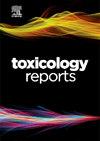Comparison of real-time instrument use and absorbent tube method for measuring formaldehyde in working environments: A health risk assessment for gross anatomy staff
Q1 Environmental Science
引用次数: 0
Abstract
Formaldehyde is widely used for the preservation of cadavers, exposing workers to potential risks of formaldehyde exposure in the workplace. This study compared the performance of real-time instruments (Gasmet) and absorbent tube methods in controlling formaldehyde levels in gross anatomy dissections with four working process areas. The concentrations of formaldehyde were determined over working periods ranging from 2 to 5 h. For the Gasmet results, a Monte Carlo simulation was applied in the uncertainty analysis to predict the formaldehyde concentration. Data collection involved questionnaires that included personal and work-related information. The Wilcoxon matched-pairs signed-rank test and intraclass correlation coefficients (ICC) were used to test–retest reliability between the two instruments. The results showed that the Gasmet direct reading and absorbent tube concentrations were not significantly different (p > 0.05) in all working areas and ICC was 0.939 indicating a highly reliable test result between the two measurements. The health-risk estimation indicated the hazard quotient and carcinogenic risk of formaldehyde. The carcinogenic risk was found to be unacceptable for all staff and processes, while the hazard quotient was found to be acceptable only in the body injection process. Future studies should employ a larger sample size and a greater number of sampling points to enhance the statistical power and precision of the results. The findings of this study can be used to improve work environments and develop strategies to reduce the risks for staff who work in gross anatomy dissections.
实时仪器与吸收管法在工作环境中测量甲醛的比较:对总解剖人员健康风险的评估
甲醛被广泛用于尸体的保存,使工人在工作场所暴露于甲醛的潜在风险中。本研究比较了实时仪器(Gasmet)和吸收管方法在控制四个工作过程区域的大体解剖解剖中甲醛水平的性能。在2至5 h的工作时间内测定甲醛浓度。对于Gasmet结果,采用蒙特卡罗模拟进行不确定性分析,预测甲醛浓度。数据收集包括个人和工作相关信息的问卷调查。采用Wilcoxon配对对符号秩检验和类内相关系数(ICC)对两种仪器之间的信度进行重测。结果表明,各工作区域的Gasmet直读和吸收管浓度无显著差异(p >; 0.05),ICC值为0.939,表明两者之间的检测结果高度可靠。健康风险评估显示甲醛的危害系数和致癌风险。发现所有工作人员和过程的致癌风险都是不可接受的,而危害商仅在人体注射过程中被发现是可接受的。未来的研究应采用更大的样本量和更多的采样点,以提高结果的统计能力和精度。本研究的结果可用于改善工作环境和制定策略,以减少在大体解剖工作的工作人员的风险。
本文章由计算机程序翻译,如有差异,请以英文原文为准。
求助全文
约1分钟内获得全文
求助全文
来源期刊

Toxicology Reports
Environmental Science-Health, Toxicology and Mutagenesis
CiteScore
7.60
自引率
0.00%
发文量
228
审稿时长
11 weeks
 求助内容:
求助内容: 应助结果提醒方式:
应助结果提醒方式:


